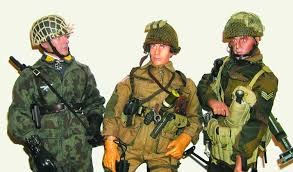Action figures have been a beloved part of pop culture for decades. From early military-style toys to the highly detailed models of today, these figures reflect changing trends in entertainment, manufacturing and collecting habits. For both beginners and long-time fans, understanding the different eras of action figures can help build a more meaningful collection and offer insights into how the industry has evolved.
Whether you’re collecting classic pieces or modern releases, knowing the history behind these figurines adds value and context to your hobby. Let’s take a journey through the key eras of action figure collecting and explore what makes each one unique.
The Birth of Action Figures: 1960s
The term “action figure” was first introduced in the 1960s when Hasbro launched G.I. Joe. These 12-inch military figures were marketed to boys as an alternative to dolls, filling a gap in the toy market. With fabric clothing, movable joints and swappable accessories, G.I. Joe figures became a household name.
This early era was defined by simplicity and function. Figures were often focused on realism rather than fantasy. Today, original G.I. Joe figures in good condition are considered valuable collector’s items.
Rise of Pop Culture Toys: 1970s
The 1970s saw a shift from military themes to entertainment-based figures. One of the biggest turning points was the release of Star Wars action figures by Kenner in 1978. These 3.75-inch toys were smaller, more affordable and easier to collect in sets. Kenner’s success with Star Wars helped set a standard for figure size and introduced the idea of toys as movie merchandise.
This era also saw figures based on TV shows and comic books, such as Mego’s superhero line. These early pop culture figurines laid the groundwork for the toy industry’s relationship with licensed characters.
Golden Age of Collectibles: 1980s
The 1980s are often considered the golden age of action figurines. With cartoons designed to promote toy lines, franchises like He-Man and the Masters of the Universe, Transformers, and Teenage Mutant Ninja Turtles dominated the market. These figures were colourful, imaginative and came with a variety of accessories.
Manufacturers began creating toy lines with entire backstories, enhancing the play experience and deepening fan loyalty. For collectors, the 1980s offer a treasure trove of nostalgic value. Original packaging and complete accessories greatly increase the worth of figures from this era.
Innovation and Detail: 1990s
In the 1990s, technology and design improvements allowed for more detailed and articulated figures. Toy companies like McFarlane Toys pushed the envelope by producing highly realistic characters from comics, films and video games. Spawn figures, in particular, introduced a level of sculpting and detail previously unseen in mass-market toys.
The 90s also expanded into sports and wrestling figures with the rise of popular lines from the WWF (now WWE). This era marked the beginning of action figures appealing to adult collectors as much as to kids.
Modern Collecting Era: 2000s to Today
From the 2000s onwards, action figures became more specialised and segmented. Major brands like Marvel Legends, Star Wars Black Series and DC Multiverse offered collector-grade figures with increased articulation, lifelike detail and character accuracy. These modern figurines are often sold in collector-friendly packaging and include digital face scans for realism.
Limited editions, exclusive releases and online pre-orders became the norm. Collectors also saw a rise in designer figures and crossover models that blended art and pop culture. This era rewards attention to detail and knowledge of market trends. Figures from conventions or short production runs often become valuable quickly.
Understanding the Collector’s Market
Each era offers something different to collectors. Vintage figures provide nostalgia and historical interest, while modern figures appeal to fans looking for accurate and poseable versions of their favourite characters. It’s important to know the characteristics of each time period:
- 1960s to 1970s: Basic articulation, cloth clothing, limited licences
- 1980s: Bright colours, original IPs, heavy media tie-ins
- 1990s: Improved detail, more diverse licences, adult collector focus
- 2000s and beyond: Highly detailed, articulation-focused, strong online market presence
Understanding these traits can help you identify and evaluate figurines, whether you’re buying or selling.
Tips for Collecting Across Eras
If you’re building a collection that spans multiple eras, keep these tips in mind:
- Do your research: Learn about figure lines, manufacturers and production years.
- Check authenticity: Watch out for reproductions and fakes, especially with vintage toys.
- Preserve condition: Store figures in cool, dry places and avoid direct sunlight.
- Consider packaging: Original packaging significantly increases a figure’s value.
- Join collector communities: Online forums and social media groups are great for sharing knowledge and trading.
Action figure collecting is more than just a hobby. It’s a journey through decades of cultural and creative history. From the military realism of the 60s to the artistic innovation of today, each era tells a story through its design and characters.
Whether you’re drawn to vintage G.I. Joe models or prefer the lifelike detail of modern superhero figurines, there’s something for every kind of collector. The more you learn about each era, the more rewarding your collecting experience will be. Take your time, enjoy the hunt and most importantly, collect what you love.


